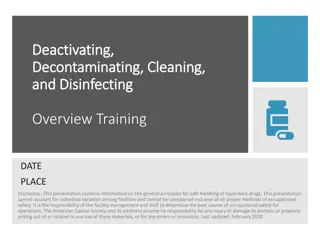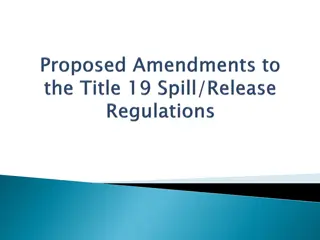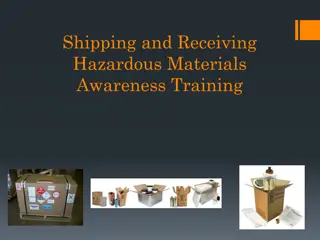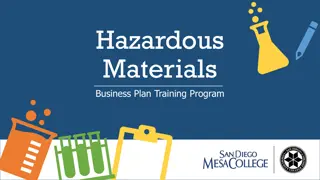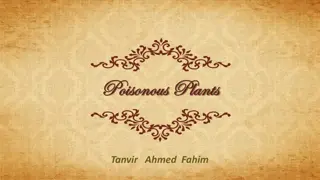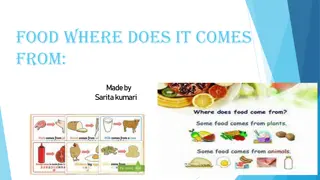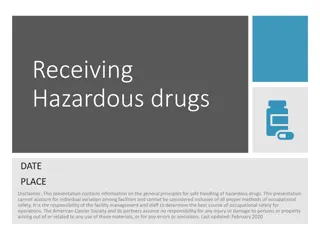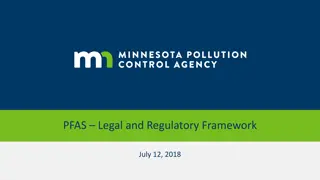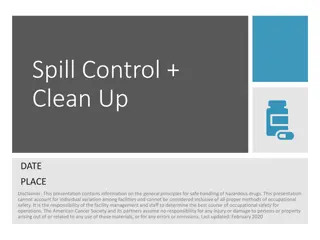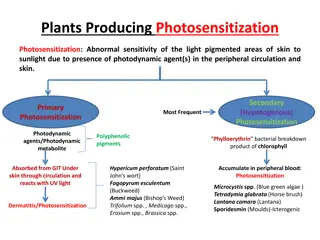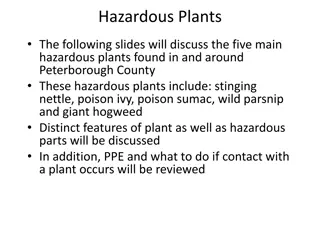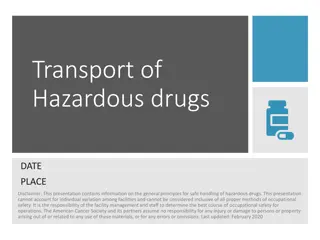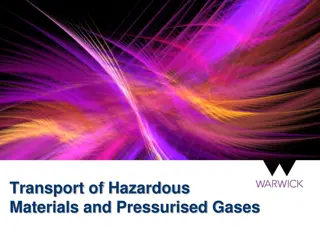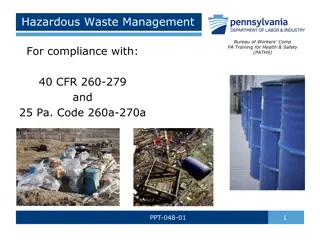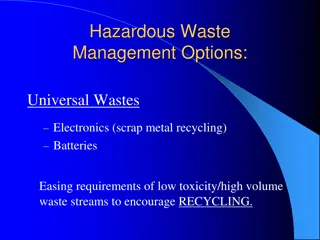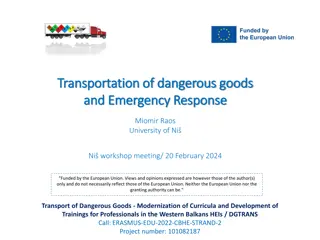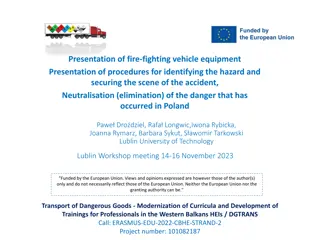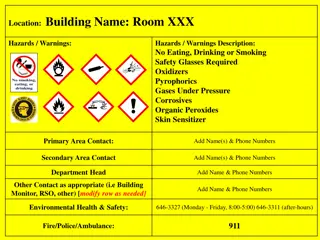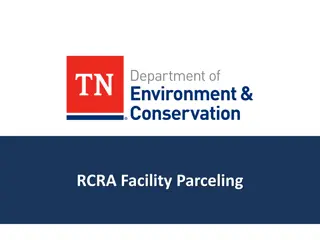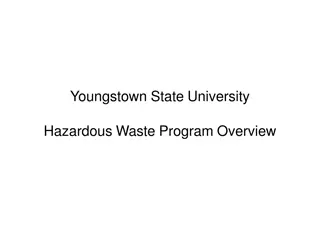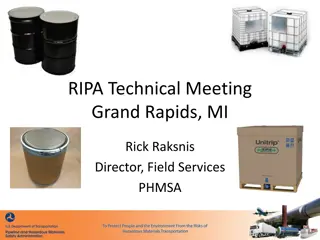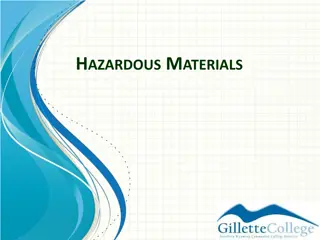Challenges and Considerations in Decommissioning Thermal Power Plants in India
Decommissioning thermal power plants (TPPs) in India involves a range of activities, from dismantling infrastructure and handling hazardous waste to environmental remediation and managing social impacts. Regulatory guidance is crucial for planning and executing decommissioning projects. With a subst
1 views • 14 slides
Energy Production
Explore different aspects of energy production and efficiency in thermal power plants, water heaters, coal-fired electrical generation plants, and natural gas electrical generation plants. Learn about energy density, mass calculations, overall efficiencies, and specific energy requirements in these
7 views • 57 slides
Emergency Services Unit and Hazardous Materials Management in Louisiana
The Emergency Services Unit (ESU) in Louisiana, along with Hazardous Materials management, focuses on preparing, preventing, responding, recovering, and mitigating hazardous incidents. Their goals include public safety through education, training, enforcement, and support of regulations at the state
5 views • 35 slides
PP Jumbo Bags in Hazardous Material Handling
In industries dealing with hazardous materials, safety is paramount. From chemical manufacturing to waste management, proper containment and transportation of hazardous substances are critical to prevent accidents, protect workers, and comply with regulations. This is where PP jumbo bag step in as i
4 views • 5 slides
Occupational Exposure to Hazardous Drugs: Risks and Prevention
Learn about the hazards of exposure to hazardous drugs, including potential health risks such as cancer, nausea, reproductive toxicity, and organ damage. Explore training modules, drug categories, and a list of hazardous drugs to ensure workplace safety. Discover NIOSH criteria for identifying hazar
1 views • 42 slides
Hazardous Drug Cleaning and Decontamination Training Overview
This presentation provides an overview of training on deactivating, decontaminating, cleaning, and disinfecting hazardous drug areas. It covers essential steps, personal protective equipment, materials, timing, and validation criteria. All areas handling hazardous drugs must undergo deactivation, de
0 views • 23 slides
Understanding Flower Variations in Plants
Explore the diverse world of flowers in plants through examples and explanations of their reproductive parts and processes. Discover how some plants have both male and female flowers, while others have separate sex flowers. Learn about perfect flowers, the female and male parts of a flower, and the
0 views • 12 slides
Proposed Amendments for Hazardous Material Release Reporting Regulations
Amendments to the hazardous material release reporting regulations include consolidating definitions, adding new definitions, changing the administering agency, updating citations, and altering notification timeframes. The amendments aim to enhance emergency response and improve reporting procedures
1 views • 18 slides
Understanding Thermal Power Plants: Overview and Operation
Thermal power plants play a crucial role in converting heat energy into electricity for various applications. This article covers the definition, layout, working principle, and components of thermal power plants, highlighting their advantages and top features. From converting heat into mechanical po
0 views • 20 slides
Understanding Transpiration and Gas Exchange in Plants
Transpiration is the evaporation of water from plants, mainly occurring through the leaves' stomata. Plants exchange gases like CO2 and O2 through various parts, without specialized organs. The process aids in photosynthesis, respiration, and cooling, demonstrating the importance of transpiration in
0 views • 22 slides
Understanding Transgenic Plants and Agrobacterium Tumefaciens in Plant Biotechnology
Creation of transgenic plants involves various methods such as microprojectile DNA-coating, electroporation, and Agrobacterium transformation. Agrobacterium tumefaciens, a soil bacterium, plays a crucial role in inducing crown gall disease in plants by transferring T-DNA from the Ti plasmid. The Ti
1 views • 27 slides
Hazardous Materials Awareness Training Overview
This training module provides essential information on shipping and receiving hazardous materials, including definitions, objectives, levels of training required, shipping regulations, and penalties for non-compliance. It covers the importance of training, regulatory guidelines, and the potential co
0 views • 21 slides
Hazardous Materials Business Plan Training Program
Facilities subject to the Hazardous Materials Business Plan (HMBP) Program must implement a training program for employees on hazardous materials safety and emergency response. This includes initial training for new employees within 30 days of hire and annual refresher training. Training covers safe
1 views • 73 slides
Understanding Poisonous Plants and Their Effects on Humans
Poisonous plants can have deleterious effects on individuals, leading to severe consequences and even death if not managed properly. These plants produce toxins that interfere with the body's essential functions, ultimately causing impairment and potential fatality. Recognizing the grades of poisoni
0 views • 11 slides
Understanding Food Sources: Plants and Animals Explained
Food is essential for nourishing our bodies, and it comes from either plants or animals. Plants provide fruits, vegetables, grains, and more, while animals offer products like meat, milk, and eggs. Different parts of plants, such as roots, stems, and leaves, are consumed as food. Animals have varied
0 views • 11 slides
Safe Handling of Hazardous Drugs: Training and Protocols
This presentation provides guidelines for the safe handling of hazardous drugs during receipt and unpacking. It covers topics such as personal protective equipment, inspecting packages for damage, and proper unpacking procedures. Staff involved in medication handling from suppliers should undergo th
0 views • 16 slides
Overview of PFAS Legal and Regulatory Framework
This document outlines the legal and regulatory framework surrounding PFAS (per- and polyfluoroalkyl substances), including hazardous waste designation, historical context at 3M sites, and the definition of hazardous substances and waste according to Minnesota statutes. It also discusses the potenti
0 views • 19 slides
Mineral Absorption in Plants: Mechanisms and Types
Plants absorb minerals from the soil as ions through the roots, with the process of mineral absorption being distinct from water absorption. Mineral absorption in plants can occur through passive or active methods, each involving different mechanisms and energy requirements. Passive absorption is a
0 views • 14 slides
Asexual Reproduction in Plants: Methods and Examples
Asexual reproduction in plants, also known as vegetative propagation, involves various methods such as tubers, bulbs, and runners. It allows plants to reproduce without the involvement of sex cells and fertilization, resulting in genetically identical offspring. Artificial propagation techniques lik
0 views • 11 slides
Hazardous Drugs Spill Control and Clean-Up Guidelines
Learn about safe handling of hazardous drugs through spill control and clean-up procedures. This presentation covers identifying spills, using spill kits, cleaning spills, reporting, and documentation. Proper training and procedures are essential to protect personnel from exposure risks. Always foll
0 views • 27 slides
Understanding Photosensitization in Plants: Causes and Toxicity
Photosensitization in plants can lead to abnormal skin sensitivity to sunlight, caused by the presence of photodynamic agents in the skin and peripheral circulation. Primary and secondary photosensitization are common, with various plants and toxins contributing to liver damage and biliary occlusion
0 views • 12 slides
Hazardous Plants Identification and Safety Guide
Explore the five main hazardous plants found in and around Peterborough County, including stinging nettle, poison ivy, poison sumac, wild parsnip, and giant hogweed. Learn about their distinct features, hazardous parts, symptoms of contact, and safety precautions. Discover how to identify these plan
0 views • 4 slides
A Closer Look at Plants and Their Importance in Our Ecosystem
Plants play a vital role in our ecosystem, not only through photosynthesis but also in regulating atmospheric gases like oxygen and carbon dioxide. Understanding the definition of plants, from green algae to flowering plants, is essential. By studying plants, we uncover their critical contribution t
0 views • 12 slides
Safe Handling of Hazardous Drugs: Training Overview
This presentation provides essential information on safe handling practices for transporting hazardous drugs within healthcare facilities. It covers training modules, types of transport activities, personal protective equipment requirements, packaging guidelines, and safety criteria for labeling and
0 views • 17 slides
Understanding Plant Classification and Characteristics
Discover the classification of plants based on their structures and characteristics, including vascular vs. nonvascular plants, seed plants vs. seedless plants, and the definitions of angiosperms, gymnosperms, dicots, and monocots. Learn about the history of plant classification and how plants are g
0 views • 27 slides
Understanding Hazardous Materials Transportation Regulations
Legislation governs the transportation of hazardous materials, including strict rules for packaging and transport. Dangerous goods are classified into nine categories, each with specific hazards. Consignors must identify, label, and package goods properly to prevent risks. Biological materials requi
0 views • 9 slides
Hazardous Waste Management Regulations in Pennsylvania
The hazardous waste management regulations in Pennsylvania outline compliance standards for handling hazardous waste, including storage, identification, transportation, recordkeeping, and emergency response. These regulations incorporate both federal guidelines under RCRA and state-specific requirem
0 views • 122 slides
Effective Hazardous Waste Management Strategies for Electronics and Batteries
Implementing proper waste management strategies for electronics and batteries is crucial to promote recycling and prevent environmental harm. The policy outlines procedures for disposing of electronic waste, including the collection of usable equipment for surplus handling. Additionally, it emphasiz
0 views • 9 slides
Proper Handling and Disposal of Hazardous Drugs and Waste
Guidelines for the safe handling and disposal of hazardous drugs and waste in healthcare facilities. The content covers training modules, waste collection, sources of healthcare waste, disposal methods, and legal regulations related to the disposal of hazardous drugs. Various types of healthcare was
0 views • 21 slides
Modernization of Curricula for Transportation of Hazardous Materials and Emergency Response Workshop
This workshop, funded by the European Union, focuses on modernizing curricula and developing training programs for professionals in the Western Balkans HEIs on the transportation of dangerous goods and emergency response. Various methods of transporting hazardous materials, such as cargo tanks, chem
0 views • 35 slides
Importance of Hazard Communication Training for Workplace Safety
Hazard communication training is essential for creating a safe work environment by helping individuals recognize and manage hazardous materials effectively. Understanding the Globally Harmonized System (GHS) and following hazard communication laws can improve workplace safety, protect human health,
0 views • 36 slides
Proper Procedures for Dealing with Hazardous Substance Spills
This presentation covers the procedures for identifying and securing hazards at the scene of an accident, as well as neutralizing dangers in Poland. It includes information on fire-fighting vehicle equipment, such as different nozzles and tools used by the fire brigade. Steps for dealing with hazard
0 views • 7 slides
Hazardous Waste Pharmaceuticals Proposed Rule Overview
This briefing provides an in-depth look at the Hazardous Waste Pharmaceuticals Proposed Rule from October 20, 2015. It covers which pharmaceuticals are considered hazardous waste, major provisions of the proposal, examples of listed hazardous waste pharmaceuticals, and the flow of hazardous waste ph
0 views • 40 slides
Occupational Safety Training in Handling Hazardous Drugs
This presentation provides guidelines and training modules for staff responsible for cleaning areas where hazardous drugs are handled, including laundry and housekeeping tasks. Topics cover personal protective equipment recommendations, cleaning procedures, disposal processes, and hygiene practices.
0 views • 18 slides
Hazardous Materials Safety Guidelines for Room XXX in Building
This document outlines the hazardous materials safety guidelines for Room XXX in the building, highlighting prohibitions on eating, drinking, and smoking, as well as the requirement for safety glasses. It includes contact information for primary and secondary area contacts, the department head, and
0 views • 4 slides
Hazardous Waste Facility Parceling Process
Hazardous Waste Facility Parceling involves subdividing permitted facilities into separate property tracts to facilitate ownership transfers. The process allows for the transfer of portions of the property, including hazardous waste management units, with specific actions and requirements for new ow
0 views • 5 slides
Youngstown State University Hazardous Waste Program Overview
The Hazardous Waste Program at Youngstown State University follows a cradle-to-grave approach, encompassing laws, regulations, inspections, roles, and responsibilities related to hazardous waste management. It delves into the identification, labeling, disposal, and transportation of hazardous waste,
0 views • 18 slides
Plant Classification and Reproduction Overview
Plants are categorized into four groups: Mosses, Ferns, Conifers, and Flowering Plants. Mosses reproduce by spores and lack roots or xylem vessels. Ferns reproduce via spores, while conifers reproduce with seeds found in cones and have needle-shaped leaves. Flowering plants reproduce using seeds fou
0 views • 8 slides
RIPA Technical Meeting Grand Rapids, MI
The Pipeline and Hazardous Materials Safety Administration's (PHMSA) strategic framework emphasizes innovation and safety in transportation of energy and hazardous materials. Goals include cultivating excellence, building trust, and pursuing operational excellence. Initiatives such as IBC repair tes
0 views • 11 slides
Safe Transportation of Hazardous Materials: A Comprehensive Guide
This comprehensive guide explores the safe transportation of hazardous materials, covering topics such as requirements for hazmat drivers, classifications of hazardous materials, handling procedures, placarding, and regulatory compliance. Learn about identifying, packaging, labeling, and transportin
0 views • 31 slides





